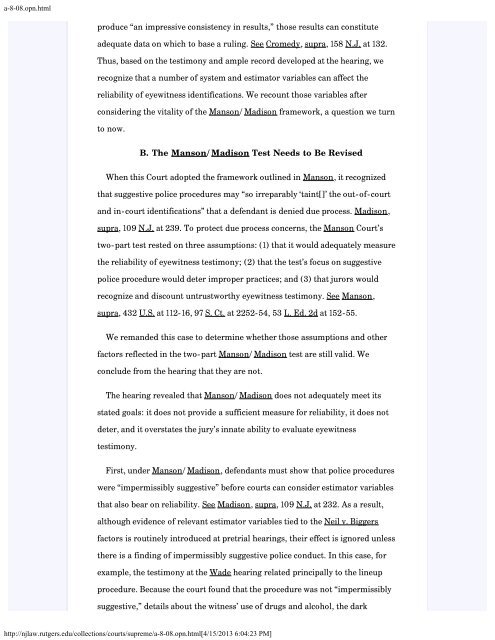State v. Henderson and the New Model Jury Charges - New Jersey ...
State v. Henderson and the New Model Jury Charges - New Jersey ...
State v. Henderson and the New Model Jury Charges - New Jersey ...
You also want an ePaper? Increase the reach of your titles
YUMPU automatically turns print PDFs into web optimized ePapers that Google loves.
a-8-08.opn.html<br />
produce “an impressive consistency in results,” those results can constitute<br />
adequate data on which to base a ruling. See Cromedy, supra, 158 N.J. at 132.<br />
Thus, based on <strong>the</strong> testimony <strong>and</strong> ample record developed at <strong>the</strong> hearing, we<br />
recognize that a number of system <strong>and</strong> estimator variables can affect <strong>the</strong><br />
reliability of eyewitness identifications. We recount those variables after<br />
considering <strong>the</strong> vitality of <strong>the</strong> Manson/Madison framework, a question we turn<br />
to now.<br />
B. The Manson/Madison Test Needs to Be Revised<br />
When this Court adopted <strong>the</strong> framework outlined in Manson, it recognized<br />
that suggestive police procedures may “so irreparably ‘taint[]’ <strong>the</strong> out-of-court<br />
<strong>and</strong> in-court identifications” that a defendant is denied due process. Madison,<br />
supra, 109 N.J. at 239. To protect due process concerns, <strong>the</strong> Manson Court’s<br />
two-part test rested on three assumptions: (1) that it would adequately measure<br />
<strong>the</strong> reliability of eyewitness testimony; (2) that <strong>the</strong> test’s focus on suggestive<br />
police procedure would deter improper practices; <strong>and</strong> (3) that jurors would<br />
recognize <strong>and</strong> discount untrustworthy eyewitness testimony. See Manson,<br />
supra, 432 U.S. at 112-16, 97 S. Ct. at 2252-54, 53 L. Ed. 2d at 152-55.<br />
We rem<strong>and</strong>ed this case to determine whe<strong>the</strong>r those assumptions <strong>and</strong> o<strong>the</strong>r<br />
factors reflected in <strong>the</strong> two-part Manson/Madison test are still valid. We<br />
conclude from <strong>the</strong> hearing that <strong>the</strong>y are not.<br />
The hearing revealed that Manson/Madison does not adequately meet its<br />
stated goals: it does not provide a sufficient measure for reliability, it does not<br />
deter, <strong>and</strong> it overstates <strong>the</strong> jury’s innate ability to evaluate eyewitness<br />
testimony.<br />
First, under Manson/Madison, defendants must show that police procedures<br />
were “impermissibly suggestive” before courts can consider estimator variables<br />
that also bear on reliability. See Madison, supra, 109 N.J. at 232. As a result,<br />
although evidence of relevant estimator variables tied to <strong>the</strong> Neil v. Biggers<br />
factors is routinely introduced at pretrial hearings, <strong>the</strong>ir effect is ignored unless<br />
<strong>the</strong>re is a finding of impermissibly suggestive police conduct. In this case, for<br />
example, <strong>the</strong> testimony at <strong>the</strong> Wade hearing related principally to <strong>the</strong> lineup<br />
procedure. Because <strong>the</strong> court found that <strong>the</strong> procedure was not “impermissibly<br />
suggestive,” details about <strong>the</strong> witness’ use of drugs <strong>and</strong> alcohol, <strong>the</strong> dark<br />
http://njlaw.rutgers.edu/collections/courts/supreme/a-8-08.opn.html[4/15/2013 6:04:23 PM]
















